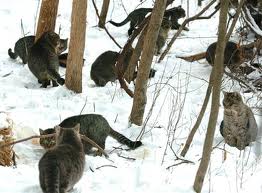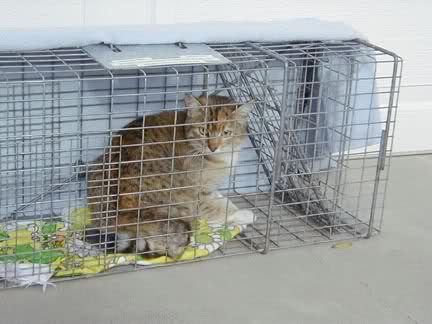Feral Cat Traps - Trapping Feral Cats Uses Basic Traps and Trapping Skills
Feral cat traps are the human way of catching these cats so that they can be given to a good home and not victimized for some sport as often happens when people come across feral cat colonies that are common in most urban areas.
However, what does trapping feral cats have to do with survival? Trapping any live wild animal can be a challenge, yet will usually require the same basic skills and traps. So whether you use those skills now to trap, neuter and release feral cats, to remove a persistent skunk, or to catch some dinner at some point, read on. You may learn something.
What is a Feral Cat?

While definitions will vary from place to place, basically a feral cat is the wild offspring of a domestic cat and are often the result of neglectful owners who don’t take care of their cats or spay or neuter them and they are left to breed out of control.
Many people leave their domestic cats behind when they move assuming they’ll find a new home on their own and be fine. Sadly that is not usually true. A domesticated cat is not going to know automatically how to feed and care for himself and many sicken and die.
The Scope of the Problem
While feral cat traps can trap and rescue a few, the problem is much bigger than a few thousand traps can solve. If left to their own devices, a pair of feral cats can have two or more litters a year and exponentially give birth to 420,000 offspring over a 7 year period!
Not your problem? Many states spend $50 million or more a year on animal control agencies, shelters, and on other cat-related expenses. That money comes from you in the form of different taxes, so it’s everybody’s problem.
Trap, Neuter, and Release
The single most effective method for reducing the feral cat population to more manageable levels is through the trap, neuter, and release program. This has been proven to be the cheapest way to deal with feral population and involves the least amount of government and citizen funding. For these programs to work they need humane feral cat traps.
These traps have to be used because most feral cats are extremely wary of humans and will not let them get close enough to catch. The program has been effective in the following ways:
- Stabilizes the population at levels that can be managed
- Humane and fosters compassion toward the cats in the neighborhoods
- Is highly effective and the least expensive program available
This has been far more effective than just trying to trap cats and euthanize them. The program keeps the new non-breeding cats in the area so breeding cats from other areas don’t move in and increase the number of feral cats. When cats are taken out of the neighborhood other breeding cats move in and the population just keeps growing.
Best Feral Cat Traps Tips

- Always use feral cat traps that are in good working condition.
- When placing your traps, put them where the cat(s) normally feed.
- Try to choose a location that is away from peoples prying eyes. Otherwise other people may come along and mess with your trap if they don’t understand that what you’re doing is good for the cat.
- Let it sit for a day or two with the trap door held open so it won’t trap the cat. This will get the cat used to going in and out and it will increase your likelihood of actually catching the cat because he is used to it.
- Smelly foods work best. Try sardines or tuna.
- Trapped cats are very vulnerable to injury so you should check your trap every 30 minutes and never leave it overnight.
Once you have trapped a feral cat you should be ready to put into action your plan. Never leave a cat in a trap more than 24 hours or they are too likely to injure themselves.
Once you have the cat in the trap cover the trap with a burlap bag or something similar. Creating a dark environment will do wonders for helping calm down a scared cat, and keep him in the dark all the way to the vet and back. Make sure you are successful with your plan because you’ll never get a chance to trap the same cat again; they’re too smart for that.
The Best Thing for the Cats
The best thing you can do for the local feral cat populations is to help control breeding. Just removing cats will only invite new ones in. Spaying and neutering existing cats will actually over time lower the local cat population to a manageable level. Always use top quality feral cat traps in good working order for the safety of the cat.
Return from Feral Cat Traps to SHTF Survival





New! Comments
Have your say about what you just read! Leave me a comment in the box below.